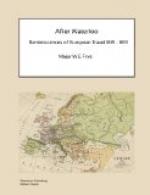[18] Philipp Klingmann (1762-1824) was better known
as an actor than as an
author.—ED.
[19] Ariosto, Orlando Furioso, VII, 12, 1.—ED.
[20] “What business have you? None, I travel
for amusement. Strange! What
is there strange in travelling
to see a fine country?”
[21] Le Compere Mathieu, a satirical novel
by the Abbe Henri Joseph
Dulaurens, published 1765
and sometimes (though wrongly) attributed to
Voltaire. One of the
prominent talkers in the dialogues is Pere Jean
de Domfront.—ED.
[22] Horace, Epist., I, i, 15.—ED.
[23] This altar, inscribed Deae Victoriae Sacrum
(Corpus inscr. lat.
XIII, 8252), was erected by
the Roman fleet on the Rhine at the place
now called Altsburg
near Cologne and, after its discovery, taken to
Bonn, where it was set up
on the Remigius-Platz (now called
Roemer-Platz) on Dec,
3, 1809. It is now in the Provincial
Museum.—ED.
[24] Ariosto, Orlando Furioso, vi, 20, 3.—ED.
[25] August Lafontaine (1758-1831), born in Brunswick
of a family of French
protestants, was the very
prolific and now quite forgotten author of
many novels and novelettes.—ED.
[26] From Ernst Moritz Arndt’s (1779-1860) celebrated
poem, Des Deutschen
Vaterland.—ED.
[27] There seems to be much truth in this opinion,
though the question of
the intrigues of Louis XVIII
with Robespierre is still shrouded in
obscurity. Some pages
of General Thiebault’s memoirs might have
cleared it up, but they have
been torn out from the manuscript
(Memoires du General Baron
Thiebault, vol. I, p. 273). Louis XVIII
paid a pension to Robespierre’s
sister, Charlotte.—ED.
[28] Sir Charles Stewart, created Lord Stewart In
1814; he was a
half-brother of Lord Castlereagh.—ED.
[29] The same story is given, with slight differences,
by Lafayette himself
(Memoires, vol.
V, p. 472-3; Paris and Leipzig, 1838). See also
Souvenirs historiques et
parlementaires du Comte de Pontecoulant,
vol. III, p. 428 (Paris,
1863). Major Frye’s narrative is by far
the
oldest and seems the most
trustworthy.—ED.
[30] The house in question was built about 1780 by
Nicolas de Pigage for
the rich merchant, Franz von
Schweizer; Pigage was the son of the
architect of King Stanislas
at Nancy. The Schweizer palace became
later on the Hotel de Russie
and was demolished about 1890, the
Imperial Post Office having
been erected in its place. The Schweizer
family is now extinct.—ED.




